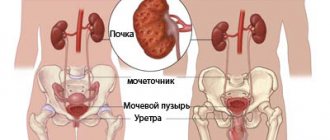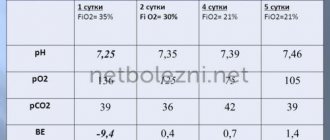Acute renal failure is a potentially reversible, sudden onset of severe impairment or cessation of renal function. Characterized by a violation of all renal functions (secretory, excretory and filtration), pronounced changes in water and electrolyte balance, rapidly increasing azotemia. Kidney failure leads to severe disturbances in metabolic processes in the body and, without treatment, leads to death from cardiac arrest.
Causes and risk factors
Etiology of prerenal acute renal failure
Prerenal acute renal failure can develop in conditions that are accompanied by a decrease in cardiac output (pulmonary embolism, heart failure, arrhythmia, cardiac tamponade, cardiogenic shock). Often the cause is a decrease in the amount of extracellular fluid (with diarrhea, dehydration, acute blood loss, burns, ascites caused by cirrhosis of the liver). May occur due to severe vasodilation that occurs during bacteriotoxic or anaphylactic shock.
Etiology of renal acute renal failure
Occurs due to toxic effects on the renal parenchyma of fertilizers, poisonous mushrooms, copper salts, cadmium, uranium and mercury. Develops with uncontrolled use of nephrotoxic medications (antitumor drugs, a number of antibiotics and sulfonamides). X-ray contrast agents and the listed drugs, prescribed in the usual dosage, can cause renal acute renal failure in patients with impaired renal function. In addition, this form of acute renal failure occurs when a large amount of myoglobin and hemoglobin circulates in the blood (with severe macrohemaglobinuria, transfusion of incompatible blood, prolonged compression of tissue during injury, drug and alcohol coma). Less commonly, the development of renal acute renal failure is caused by inflammatory kidney disease.
Etiology of postrenal acute renal failure
It develops when there is a mechanical disturbance in the passage of urine due to bilateral obstruction of the urinary tract by stones. Less commonly occurs with tumors of the prostate gland, bladder and ureters, tuberculous lesions, urethritis and periurethritis, dystrophic lesions of the retroperitoneal tissue. In severe combined injuries and extensive surgical interventions, acute renal failure is caused by several factors (shock, sepsis, blood transfusion, treatment with nephrotoxic drugs).
Pathogenesis
Acute renal failure (ARF)
is
a sudden disorder of kidney function with a delay in the excretion of nitrogen metabolism products from the body and a disorder of water, electrolyte, osmotic and acid-base balance.
Epidemiology
The incidence in the European population is 200 per 1,000,000 population per year. In more than half of the cases, the causes of acute renal failure are multiple trauma and surgery on the heart and large vessels. Hospital acute renal failure accounts for 31-40%, another 15-20% is due to obstetric and gynecological pathology.
Classification
- Prerenal (ischemic), caused by acute impairment of renal blood flow (about 55% of cases).
- Renal (parenchymal), resulting from damage to the renal parenchyma (in 40% of patients).
- Postrenal (obstructive), developing as a result of an acute violation of the outflow of urine (noted in 5% of cases).
Etiology
- Prerenal acute renal failure:
- Reduced cardiac output (cardiogenic shock, cardiac tamponade, arrhythmias, heart failure, pulmonary embolism, bleeding, especially obstetric).
- Systemic vasodilation (endotoxic shock in sepsis, anaphallaxis, use of vasodilators).
- Sequestration of fluid in tissues (pancreatitis, peritonitis).
- Dehydration with prolonged vomiting, profuse diarrhea, prolonged use of diuretics or laxatives, burns.
- Liver diseases with the development of hepatorenal syndrome.
- Renal acute renal failure:
- Postischemic AKI develops in the situations listed in the etiology of prerenal AKI; is an unfavorable outcome of prerenal acute renal failure with aggravation of arterial hypertension (AH) and renal ischemia.
- Exogenous intoxications.
- Hemolysis or rhabdomyolysis.
- Inflammatory kidney diseases, including as part of infectious pathology.
- Renal vascular lesions.
- Injury or removal of a single kidney.
Postrenal acute renal failure:
- Prerenal acute failure:
Hypoperfusion of renal tissue, depending on the severity and duration, causes reversible and sometimes irreversible changes.
- Hypovolemia leads to stimulation of baroreceptors, which is naturally accompanied by activation of the sympathetic nervous system, the renin-angiotensin-aldosterone system and the secretion of antidiuretic hormone.
- The renal autoregulation mechanism is activated: the tone of the afferent arteriole decreases and the tone of the efferent arteriole increases, an imbalance occurs towards afferent vasoconstriction with ischemia of the renal cortex and a decrease in glomerular filtration rate (GFR).
The pathogenesis varies depending on the type of renal acute renal failure.
- With the development of ischemia of the renal parenchyma and/or exposure to nephrotoxic factors, acute tubular necrosis develops.
- Ischemic kidney damage with the development of acute renal failure is most likely after cardiac surgery, major trauma, and massive bleeding. The ischemic variant of acute renal failure can develop even with a normal level of blood volume, if there are risk factors such as sepsis, the use of nephrotoxic drugs, and the presence of previous kidney disease with chronic renal failure.
A). In the initial stage of ischemic acute renal failure, GFR decreases.
b). In the advanced stage of ischemic acute renal failure (lasting 1-2 weeks), GFR reaches a minimum level (5-10 ml/h), while it remains low even with hemodynamic restoration. The main role is attributed to disturbances of local regulation leading to vasoconstriction.
V). The recovery phase is characterized by gradual regeneration of the tubular epithelium of the kidneys. Before the function of the tubular epithelium is restored, polyuria is noted in this phase.
· AKI caused by nephrotoxins is most likely in older people and patients with initially impaired renal function. The central link is nephrotoxin-induced vasoconstriction, leading to changes in the microcirculation in the kidneys.
- AKI against the background of myoglobinuria or hemoglobinuria develops due to obstruction of the tubules by pigment casts, as well as the direct toxic effects of the destruction products of hemoglobin and myoglobin.
- AKI can develop with rapidly progressive glomerulonephritis, especially occurring against the background of a persistent bacterial or viral infection, which is caused by frequent episodes of dehydration and the nephrotoxic effect of massive antibacterial and antiviral therapy.
Postrenal acute renal failure:
Usually occurs due to obstruction of the urinary tract below the orifices of the ureters. Obstruction in the path of urine outflow leads to increased pressure in the ureters and pelvis. Acute obstruction initially results in a mild increase in renal blood flow, which is quickly followed by vasoconstriction and a decrease in GFR.
Symptoms and course of acute renal failure
There are four phases of acute renal failure:
- Initial phase of surge arrester
The patient's condition is determined by the underlying disease causing acute renal failure. Clinically, the initial phase is usually not detected due to the absence of characteristic symptoms. The circulatory collapse that occurs in this phase has a very short duration and therefore goes unnoticed. Nonspecific symptoms of acute renal failure (drowsiness, nausea, lack of appetite, weakness) are masked by manifestations of the underlying disease, injury or poisoning.
- Oligoanuric phase of acute renal failure
Anuria occurs rarely. The amount of urine excreted is less than 500 ml per day. Characterized by severe proteinuria, azotemia, hyperphosphatemia, hyperkalemia, hypernatemia, metabolic acidosis. There is diarrhea, nausea, and vomiting. With pulmonary edema due to overhydration, shortness of breath and moist rales appear. The patient is lethargic, drowsy, and may fall into a coma. Pericarditis and uremic gastroenterocolitis often develop, complicated by bleeding. The patient is susceptible to infection due to decreased immunity. Possible pancreatitis, stomatitis, mumps, pneumonia, sepsis.
The oligoanuric phase of acute renal failure develops during the first three days after exposure. Late development of the oligoanuric phase is considered a prognostically unfavorable sign. The average duration of this stage is 10-14 days. The period of oliguria can be shortened to several hours or extended to 6-8 weeks. Prolonged oliguria more often occurs in elderly patients with concomitant vascular pathology. In the oliguric stage of acute renal failure, which lasts more than a month, it is necessary to carry out additional differential diagnosis to exclude progressive glomerulonephritis, renal vasculitis, occlusion of the renal artery, diffuse necrosis of the renal cortex.
- Diuretic phase of acute renal failure
The duration of the diuretic phase is about two weeks. Daily diuresis gradually increases and reaches 2-5 liters. There is a gradual restoration of water and electrolyte balance. Hypokalemia is possible due to significant losses of potassium in the urine.
- Recovery phase
There is further restoration of renal function, which takes from 6 months to 1 year.
Anatomy and function of the kidneys
The kidneys are an extremely efficient organ. With their mass being 0.4% of body weight, organ blood flow accounts for 25% of cardiac output. Metabolic processes in the kidneys are accompanied by the use of 10% of the total oxygen necessary for the functioning of the body.
In the kidneys, blood ultrafiltration processes occur with the formation of about 150 liters of primary urine per day. Ultrafiltration is carried out only with an effective filtration pressure of at least 12 mm Hg. Art. It is calculated by the difference between hydrostatic (47 mmHg), oncotic plasma pressure (25 mmHg) and intracapsular (10 mmHg) pressure. Therefore, when hydrostatic (mean arterial) pressure decreases or when intracapsular pressure increases to more critical values, filtration stops and renal failure develops.
The renal tubules carry out the process of reabsorption of water, electrolytes, and other substances, as well as secretion. As a final result, about 1% of urine is excreted from the body, now secondary, which contains a high concentration of waste.
The kidneys are involved in hematopoiesis, regulation of water-electrolyte status and acid-base balance. The kidney is also a secretory organ. Renin is synthesized in its parenchyma, which plays an important role in the formation of arterial vascular tone (blood pressure).
Complications of acute renal failure
The severity of disorders characteristic of renal failure (fluid retention, azotemia, water-electrolyte imbalance) depends on the state of catabolism and the presence of oliguria. With severe oliguria, there is a decrease in the level of glomerular filtration, the release of electrolytes, water and nitrogen metabolism products is significantly reduced, which leads to more pronounced changes in blood composition.
- Disturbances of water-salt metabolism
With oliguria, the risk of developing water and salt overload increases. Hyperkalemia in acute renal failure is caused by insufficient excretion of potassium while the level of its release from tissues remains unchanged. In patients who do not suffer from oliguria, the potassium level is 0.3-0.5 mmol/day. More pronounced hyperkalemia in such patients may indicate an exogenous (blood transfusion, medications, presence of potassium-rich foods in the diet) or endogenous (hemolysis, tissue destruction) potassium load.
The first symptoms of hyperkalemia appear when potassium levels exceed 6.0-6.5 mmol/L. Patients complain of muscle weakness. In some cases, flaccid tetraparesis develops. ECG changes are noted. The amplitude of the P waves decreases, the PR interval increases, and bradycardia develops. A significant increase in potassium concentration can cause cardiac arrest.
In the first two stages of acute renal failure, hypocalcemia, hyperphosphatemia, and mild hypermagnesemia are observed.
- Blood changes
The consequence of severe azotemia is inhibition of erythropoiesis. The lifespan of red blood cells is reduced. Normocytic normochromic anemia develops.
- Immune disorders
Immune suppression contributes to the occurrence of infectious diseases in 30-70% of patients with acute renal failure. The addition of infection aggravates the course of the disease and often causes the death of the patient. Inflammation develops in the area of postoperative wounds, the oral cavity, respiratory system, and urinary tract suffer. A common complication of acute renal failure is sepsis, which can be caused by both gram-positive and gram-negative flora.
- Neurological disorders
There is drowsiness, confusion, disorientation, lethargy, alternating with periods of excitement. Peripheral neuropathy occurs more often in older patients.
- Complications from the cardiovascular system
With acute renal failure, congestive heart failure, arrhythmia, pericarditis, and hypertension may develop.
- Disorders of the gastrointestinal tract
Patients are concerned about a feeling of discomfort in the abdominal cavity, nausea, vomiting, loss of appetite. In severe cases, uremic gastroenterocolitis develops, often complicated by bleeding.
Symptoms of kidney failure (KF)
There are four phases of acute renal failure. In the initial stage, the patient’s condition is determined by the underlying disease causing acute renal failure. There are no characteristic symptoms. Nonspecific symptoms of acute renal failure - deterioration of health, loss of appetite, nausea, vomiting, diarrhea, swelling of the lower and upper extremities, increased liver volume, lethargy or agitation of the patient - are masked by manifestations of the underlying disease, poisoning or injury.
During the first stage of the disease, which lasts from several hours to several days, pronounced pallor of the skin and characteristic abdominal pain caused by acute intoxication also appear.
During the second phase (oligoanuric), there is a sharp decrease in the amount of urine excreted. During this period, metabolic end products accumulate in the blood, the main of which are nitrogenous wastes. Due to the cessation of kidney functions, the acid-base balance and water-electrolyte balance are disturbed.
As a result of these processes, the following symptoms of acute renal failure occur: nausea, vomiting, loss of appetite, peripheral edema, cardiac arrhythmia and neuropsychiatric disorder.
Due to acute fluid retention in the body, edema of the brain, lungs, ascites or hydrothorax may develop.
The oligoanuria stage lasts on average two weeks, its duration depends on the extent of kidney damage, the adequacy of the treatment and the rate of restoration of the renal tubular epithelium.
The third stage (restorative) is characterized by a gradual restoration of diuresis and takes place in two stages. During the first, the daily amount of urine does not exceed 400 ml (initial diuresis), then there is a gradual increase in the volume of urine - up to two liters or more. This indicates regeneration of the glomerular function of the kidney.
The diuresis stage lasts 10-12 days. During this period, the activity of the cardiovascular and respiratory systems and digestive organs is normalized.
The fourth stage is the recovery stage. Completely regenerate kidney function. Recovery of the body after long-term treatment can last from several months to one year or more. During this period, the volume of urine excreted, water-electrolyte and acid-base balance are normalized. In some cases, acute renal failure can become chronic.








